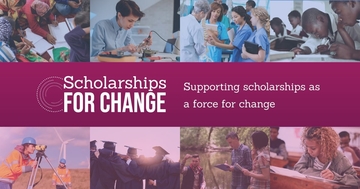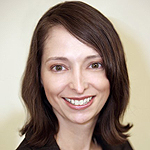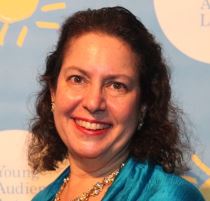Case Studies Reveal How Donors are Changing the World One Scholar at a Time An Interview with Author, Jane L. Polin
Scholarships for Change is a new, open-access website created by Candid that explores how donors are using scholarships as a force to accelerate the broader change they hope to see in the world. Though all scholarships can change lives, some scholarships are also designed to improve institutions, communities, economies, industries and even whole regions. Scholarships for Change pulls together data and knowledge to tell the story of how philanthropic dollars are achieving such change and guides funders in the practice of scholarship grantmaking.
Jane L. Polin authored a series of 12 new GrantCraft case studies for Scholarships for Change, spotlighting established programs with an impressive record of change. She brings nearly four decades of innovative leadership experience within the nonprofit and private sectors in high-impact investment of philanthropic resources. Now serving as a philanthropic advisor, principally in the fields of the arts, education, and workforce development, she has completed complex assignments for a diverse set of national clients, including field-building initiatives, such as Funding Futures: Scholarships as Agents of Social Change (2016) for The Ford Foundation; Transforming Arts Teaching: The Role of Higher Education (2007) for the Dana Foundation; and the National Fund for Workforce Solutions, an award-winning funder collaborative launched in 2007.
In this interview, Janet Camarena, director of transparency initiatives for Candid, discusses Jane’s insights and reflections about the new Scholarships for Change case study series.
Janet Camarena: Jane, you’ve devoted much of your career to helping donors think through the impact they want to make with their education dollars. Are there any trends you’ve noticed in the field of funding greater access to higher education and how did those trends surface in the case studies?
Jane L. Polin: Yes, several trends can be observed in these case studies. First, the traditional emphasis on college access has been replaced by a commitment to completion. Too many students begin college, and do not obtain their degrees. Only 58% of U.S. college students complete their post-secondary degrees within six years. Second, high-need students require much more than financial aid to cover tuition expenses; recognition is growing that they require comprehensive assistance. Third, institutions are changing their practices and policies to better support scholarship students, but a more widespread use of proven practices is still needed. That’s why illuminating real innovations, such as the emergency grant program advanced by Ascendium Education Group, is so important. Fourth, the core issues and needs are global in nature. That’s why the Mastercard Foundation is facing many of the same concerns in African nations as the Kauffman Foundation has encountered in the greater Kansas City region. Making such connections between programs and sharing approaches across geographies are both of immense value to the field. Fifth, in speaking with the program leaders, I found an eagerness to learn from the experiences of others. That’s indicative of a healthy trend to learn from those with experience, a track record of change, and a willingness to share lessons learned.
JC: Since new donors often enter philanthropy by making a scholarship award, what do the case studies have to offer about the best way for these donors to begin to think about the impact they want to make?
JLP: Engaging in a learning process is essential. To begin, I would suggest donors to spend time considering their responses to the 12 questions posed in the Donor Resource Guide we developed for Funding Futures: Scholarships as Agents of Social Change. The first three questions address donor aspirations: What is your goal? How will you define success? How will you measure progress toward success? These simple but not easy questions demand thoughtful deliberation.
I would then urge donors to explore the Scholarships for Change case studies; they will find both ideas and inspiration. Over 12 weeks or months, they can discuss: What are the key lessons we see here? What are the implications for what we want to do? Do we want to pursue our own program purpose, or perhaps join an established one, such as TheDream.US that’s working to support degree attainment for students with DACA status, or further increase achievement for students of color with The Jackie Robinson Foundation?
Allowing sufficient time for learning, planning, and relationship-building is necessary for success. As the case studies reveal, the donors both “learned by doing” and enabled their efforts to evolve over time. But a substantial investment of time and thought prior to program launch was critical to maximizing impact and minimizing missteps.
JC: The donors profiled in the case studies were intentionally selected to represent a wide cross-section of the field. Despite the variety, did you find any common themes or approaches across the case studies that might be helpful for those entering the field?
JLP: The most critical common denominator across the 12 studies is that careful attention to program design drives impact. Finding, defining, and refining a focus, and making design choices that support that focus, creates a “what” and a “who” for the program. In the LeBron James Family Foundation case study and in other instances, the definition of “where,” or a sense of place, is a primary focus factor. Another feature that distinguishes these cases is their time orientation: the “when” is viewed in terms of decades, not days. After creating consensus for the “why” through a learning process, and the “what,” “who,” where,” and “when” during a planning process, these programs have all excelled at the “how:” high-quality implementation. When challenges were encountered, or results were disappointing, they adjusted their approaches. They also listened to all of their stakeholders, especially the scholarship students themselves.
JC: One of my favorite aspects of this effort is the many inspiring stories of change you were able to document. Can you pick one or two to highlight that give our audience an idea of the scale of change donors have been able to achieve through scholarships?
JLP: Fully agree, Janet. One of the myths concerning scholarship support is that the impact is limited, and matters only to the recipient. Not true! As with the Abdulla Al Ghurair Foundation, program beneficiaries are having a profound “multiplier” effect on other individuals, institutions, and issues. The STEM Scholars we featured are already increasing inclusion beyond the university and throughout the Middle East and North Africa region in ways that impact thousands of lives, yet they are just three of an anticipated 15,000 program participants. A vast scale of change has been well-documented by the Ford Foundation’s International Fellowships Program (IFP), a global initiative focused on developing social justice leaders. The associated 10-year tracking study is a rarity in the scholarship field. Having reached its mid-way point, the IFP alumni tracking study is documenting how 4,305 individuals, often overlooked by other higher education programs, are now leading change in their communities, nations, and fields of interest. Vo Thi Hoang Yen, the IFP fellow featured in the case study, has become an honored leader in advocating for persons with disabilities throughout southeast Asia. Her example, multiplied by thousands, shows how well-designed scholarship support can yield large-scale, transformational change.
JC: If you were to start a Jane L. Polin Scholarship Program in the future, what might you do differently than might have otherwise been the case, based on what you learned from your case study research?
 JLP: Scholarship support is personal for both of us, Janet. I’ll always be grateful for the donors who made my undergraduate and graduate degrees possible. I’ve actually made an initial commitment to funding a Jane L. Polin Scholarship at Wesleyan University, designating my support for a student of independent status. Now, if I had the resources to fund an entire program, I’d put on my professional hat and consider various lessons from Scholarships for Change. For one, donors can influence each other, and leverage can be a powerful tool in creating greater and sustained impact, as we found in the Bonner Program. Among the exciting examples we explored is how the Los Angeles Scholar Investment Fund enabled existing resources to achieve greater impact through more effective use of pooled and aligned funds with a select set of higher education institutions. So, in designing any scholarship program, I’d be even more mindful of how coalitions of donors and institutions can come together to achieve even larger and more lasting impact.
JLP: Scholarship support is personal for both of us, Janet. I’ll always be grateful for the donors who made my undergraduate and graduate degrees possible. I’ve actually made an initial commitment to funding a Jane L. Polin Scholarship at Wesleyan University, designating my support for a student of independent status. Now, if I had the resources to fund an entire program, I’d put on my professional hat and consider various lessons from Scholarships for Change. For one, donors can influence each other, and leverage can be a powerful tool in creating greater and sustained impact, as we found in the Bonner Program. Among the exciting examples we explored is how the Los Angeles Scholar Investment Fund enabled existing resources to achieve greater impact through more effective use of pooled and aligned funds with a select set of higher education institutions. So, in designing any scholarship program, I’d be even more mindful of how coalitions of donors and institutions can come together to achieve even larger and more lasting impact.
Conducting the interviews and related research revealed the extraordinary range of scholarship program endeavors – they are as varied as the donors themselves. Donors can choose to be visible ambassadors who offer a personal presence, such as the Jonas and Soros families, or they can be unseen partners. Whether the donor is visible or invisible, their stories will be best told through the years by the students and alumni of the scholarship programs created during their lifetimes. As the closing song from the Broadway musical Hamilton asks us, “Who tells your story?”




